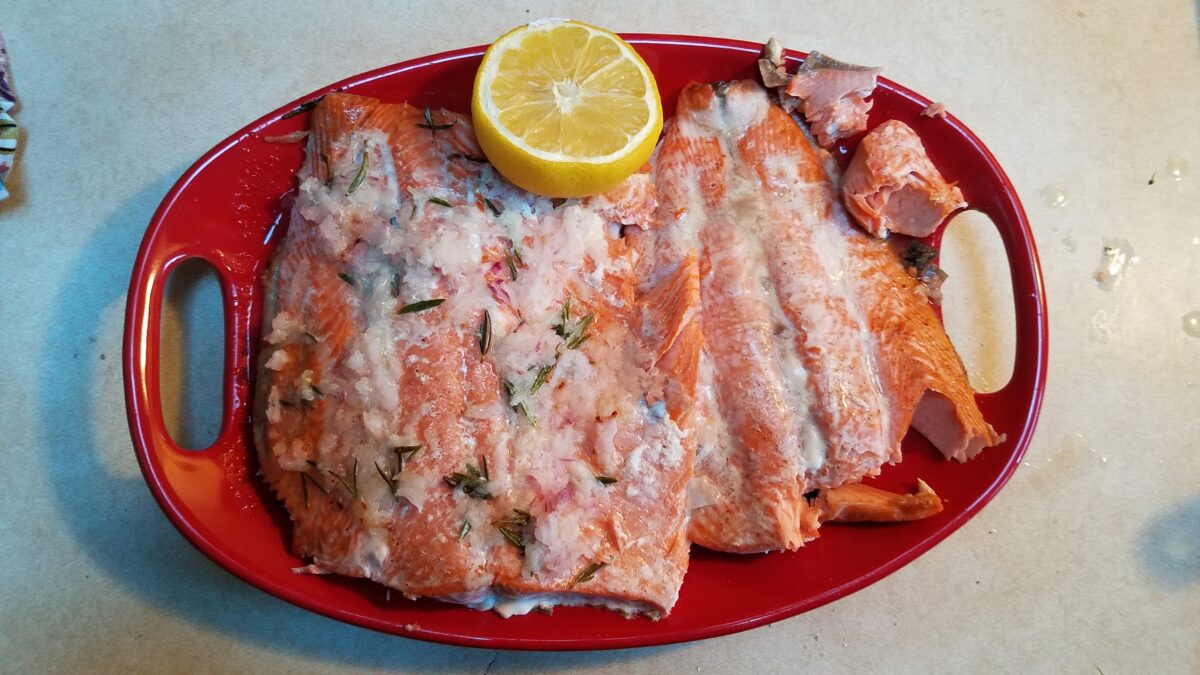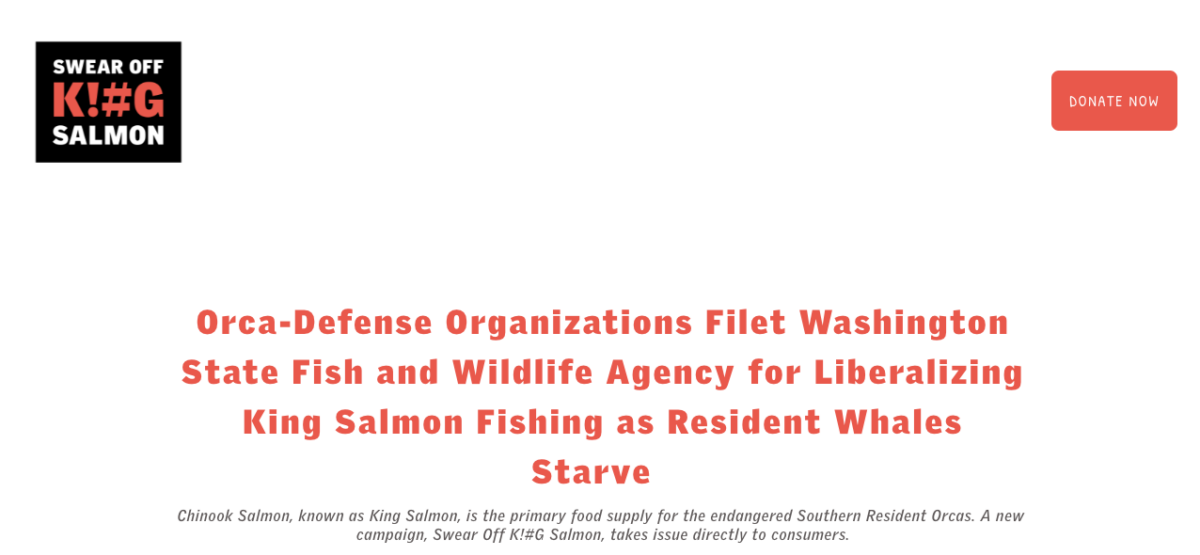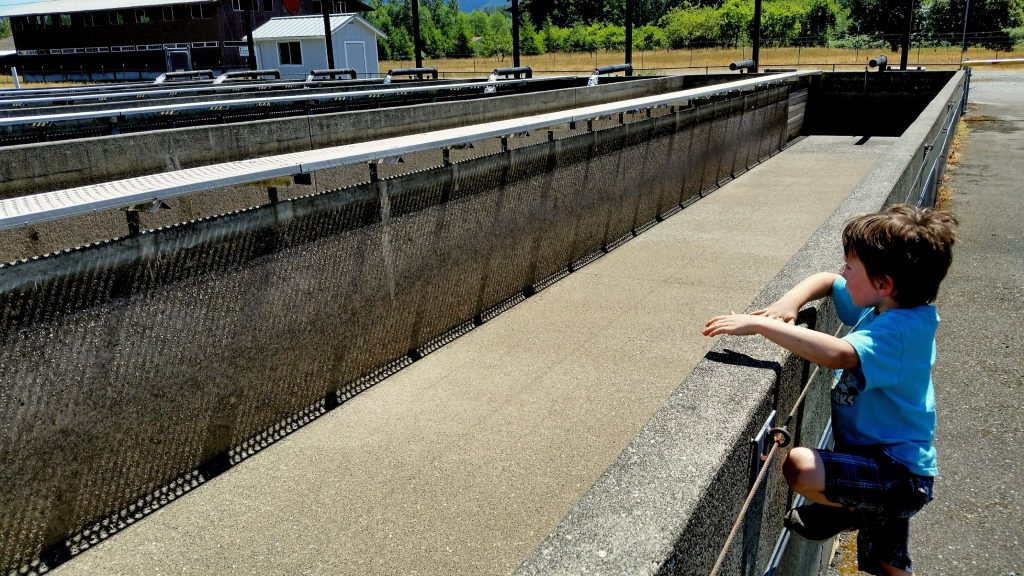
Orgs Cut Selves Trying To Fillet WDFW Over Ocean Chinook
Highly litigious environmental organizations have a serious flaw in their upcoming pressure campaign to blast the Washington Department of Fish and Wildlife for its allegedly “seriously flawed plan to liberalize the take of Chinook” this season.
A West Coast-wide, multi-stakeholder ocean salmon management body actually proposed 2023’s harvest options and set final quotas for Chinook, not WDFW, and federal overseers right up to the U.S. Secretary of Commerce are the ones who signed off on it all this week, not WDFW.

Those sorts of fine distinctions will be lost, however, as the Center for a Humane Economy, Washington Wildlife First and Wild Fish Conservancy attempt to persuade grocery store shoppers not to buy Chinook, and restaurateurs not to serve it to customers.
“Help save the orca! Swear off K!#G Salmon!” is their tag line in a newly minted website that surfaced with the Southeast Alaska Chinook ruling earlier this month and until very recently was password protected. “Together, we can make King Salmon a bad word for a good cause.”
The trio claim that WDFW “should be maximizing the conservation of both endangered orcas and wild Chinook Salmon in the long-term, not the short-term bottom line of commercial fishing interests.”
Insert. Eyeroll. Here.

It’s all willfully misleading, and on multiple levels.
Each winter, the Pacific Fishery Management Council – a regional body established by Congress’s 1976 Magnuson-Stevens Act, with voting representatives from the National Marine Fisheries Service, four states, nontribal and tribal fishing interests, and the marine conservation world – reviews the past season and collects Chinook run forecasts for the coming season and then considers how to ensure longterm conservation goals for stocks are met, attempts to provide harvest on abundant runs and spread it between ports and fisheries, and meet treaty fishing rights obligations.
Earlier this year, PFMC came up with ocean Chinook harvest options ranging from a low of 95,000 for the Washington and North Oregon Coasts to a high of 135,000, before ultimately settling on 123,000, which is just slightly above the average for the previous 10 years of 121,000. That final figure will be split three ways – 39,000 for nontribal anglers out of ports like Warrenton, Westport and Neah Bay, among others, 39,000 for nontribal commercial fishermen like the troll fleet recently highlighted on Seattle TV station KING 5, and 45,000 for tribal fishermen like the Makahs.
True, the overall ocean Chinook quota is up 29,210 fish from last year (though still well below 2014 and 2015 levels of 180,000 and 193,000, respectively) and the plight of starving southern resident killer whales is front and center in the region, but the fisheries were also set and ultimately approved by Commerce Secretary Gina M. Raimondo with those iconic marine mammals in mind.
“The Council developed the management measures consistent with the FMP including Amendment 21, which NMFS evaluated consistent with NEPA, and in an ESA biological opinion concluding fisheries managed according to the provisions are not likely to jeopardize SRKW,” states NMFS in posting the 2023-24 West Coast salmon seasons to the Federal Register Thursday.
Now, I recognize that the above paragraph is on the meaty side for those who don’t follow these arcane processes, so let me attempt to – sticking with the dot.orgs’ cutting metaphor – flesh it out.
* FMP stands for fishery management plan – in this case, for salmon fisheries in federal waters from 3 to 200 miles off Washington, Oregon and California, the U.S.’s exclusive economic zone;
* Amendment 21 is essentially a recent chapter tacked onto the FMP that addresses the plight of SRKWs and states that fisheries will be even more restricted up and down the coast if the prefishing abundance of Chinook falls below 623,000 – this year’s forecast is for 889,900;
* And of course NEPA and ESA are self-explanatory as federal acts requiring careful management through the lenses of environmental policies and endangered species.
So, there’s not exactly a lot of wiggle room for WDFW to independently decide to get whacky – not to mention unneighborly and thumb its nose at this year’s California and South and Central Oregon Coast Chinook shutdowns (meant to protect California stocks that pasture to a fairly limited degree off Oregon) and the recent federal ruling against the Southeast Alaska commercial troll fishery biological opinion – and willy-nilly liberalize Washington king seasons, and damn the orcas in the deal.

I know for a fact that the smart folks at CHE, WWF and WFC know all that; they couldn’t be suing NMFS, WDFW, the Washington Fish and Wildlife Commission, your grandma, backyard, etc., etc., etc., if they weren’t sharply clued into how all of this actually works.
In fact, it’s funny, if WFC truly cared so much about the availability of Chinook for orcas, it wouldn’t be trying to shut down recent years’ increased hatchery Chinook production meant specifically for orcas, both in federal court – where they recently got shot down on that particular front – and in Washington superior court – where local tribes are joining a lawsuit so they can file motions to take out WFC’s rubbish.
“A disruption to the prey increase program, or its funding, thus appears primed to result in gaps in prey abundance that would lead to increased risk to the health of the SRKW and threaten any future operation of the program,” wrote federal Magistrate Judge Michelle L. Peterson in her 40-page recommendation last winter to deny WFC’s motion to defund the program.
US District Court Judge Richard A. Jones didn’t even bat an eye in disagreement with her when he made his final ruling on Southeast Alaska Chinook fishing earlier this month.
That sort of common sense isn’t easy for some to accept, especially when there’s a buck to be made in court, so they have to resort to emotional ploys.
“When will our agencies put the long-term survival of Southern Residents or wild Chinook first?” bemoans Washington Wildlife First’s Samantha Bruegger in the campaign press release. “Extinction is just around the corner and then it will be too late.”
To be abundantly clear, SRKWs are in bad shape based on a strict diet requirement that doesn’t go well with plopping a civilization of tens of millions of people on top of their freshwater habitat and making token gestures to spruce it up. (Recovering wild Chinook will take decades SRKWs don’t have, 90 years just for estuaries, per KUOW.) Not a token gesture is that Washington’s inside Chinook fisheries in prime orca foraging waters have already been pruned back 90 percent – without apparent effect on their population.
Drastically reducing Chinook hatchery production over past decades, on the other hand …

This afternoon I asked WDFW if it wasn’t already putting Chinook and orcas first in its management decisions.
Samantha Montgomery, the agency’s communications manager, replied with the following statement:
Our fishing seasons reflect input and oversight from state and federal partners, including National Oceanic and Atmospheric Administration (NOAA) Fisheries, the Pacific Salmon Commission and the Pacific Fisheries Management Council (PFMC) and consider ecosystem impacts and multi-species conservation and recovery objectives, including Southern Resident Killer Whales.
NOAA Fisheries is publishing a notice of decision (NOD) on approving the Pacific Fishery Management Council’s proposed amendment … to the Pacific Coast Salmon Fishery Management Plan known as “Amendment 21” which would limit ocean salmon fishery impacts on Chinook salmon availability as prey for endangered SRKWs, during years of particularly low Chinook salmon abundance. Amendment 21 sets a threshold for annual Chinook salmon abundance, currently estimated at 623,000 in waters north of Cape Falcon, Oregon, below which the Council and NOAA Fisheries would take additional fishery management actions through the adoption of annual ocean salmon management measures. Above this abundance threshold, ocean salmon fisheries will be managed consistent with the existing Pacific Coast Salmon Fishery Management Plan. For details, go to NOAA Fisheries website.
WDFW is working with state, federal, and tribal governments to implement various recovery actions to support orca and salmon recovery and protect these iconic species for the future. Ensuring that prey is available for Southern Resident Killer Whales is a critical part of the recovery strategy along with habitat restoration and reducing vessel traffic around the whales. More information on this topic can be found here: Conservation-minded approach to fisheries management supports sustainable salmon for Southern Resident orcas — and people | by The Washington Department of Fish and Wildlife | Medium
Yeah, I know, it’s all on the dry side, a little like salmon left in the oven or on the barbecue too long.
Don’t leave fish on heat too long; that’s what I’ll be remembering this weekend as I – hopefully anyway, knowing my luck – cook up a hatchery spring Chinook caught out of the creek for Mother’s Day.
No f*@%ing way I’m swearing off king salmon.
I’ve been reporting on Wild Fish Conservancy’s myriad WDFW lawsuits over the years as well as Washington Wildlife First’s efforts to reform WDFW and the Fish and Wildlife Commission, including the secret Vashon Island meeting where this idea may have germinated, but the Swear off K!#G Salmon campaign is headed up by the Center for Humane Economy‘s Jennifer Ashton McCausland.
CHE’s president is Wayne Pacelle of HSUS infamy, and insiders will recognize McCausland’s name from various debates over Washington wolf and cougar management, and as a contributor to Governor Inslee’s previous reelection campaigns.
In former Spokane Spokesman-Review outdoor writer Eli Franovich’s new book The Return of the Wolves, McCausland is described as “a rich Australian émigré with a passion for classical music, politics, and wolves” who hosted a meeting at her mansion overlooking Lake Washington for the rich and powerful looking to bend the governor’s ear. In puzzling George Santos-level resume padding, she also claims to have “ended the state of Washington’s wolf eradication policy.”
But let’s not get sidetracked on wolves, four-legged and the kind gunning for WDFW here – political and organizing pros.
To be clear, if Northwesterners want to go with avocado toast and plant-based chicken instead of Chinook, that’s fine by me, it’s their choice.
For me, fishing for and eating Chinook reaffirms and reinforces my lifelong connection to the Northwest and the region’s native food and productivity, as well as strengthens my resolve to advocate for what the fish need. I imagine it’s similar for coastal trollers whose livelihoods will now be in the crosshairs.
This don’t-eat-fish campaign struck one of my learned sources as more of a fundraiser than an actual conservation effort. To me it feels like a slightly warmed over PETA stunt.
Cue the paid activists dressed up as orcas invading Pike Place Market and stealing filets out of shoppers’ bags and the disingenuous morality police forking filets off diners’ plates.
F!#k that bullsh*t.

